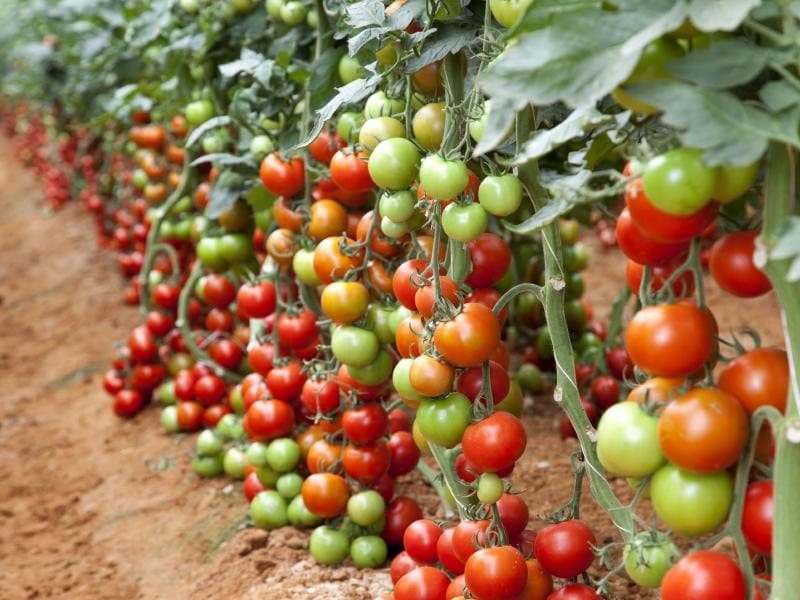Want to know how to feed the tomatoes in the greenhouse? Look for the best methods in the article.
Contents
- Why and how often you need to feed tomatoes in the greenhouse: when planting and during growth
- How to make fertilizers for feeding a tomato in a greenhouse: Rules and recommendations
- How can you feed tomatoes in a greenhouse: the use of complex mineral fertilizers
- Organic fertilizers for subcortex of tomatoes in a greenhouse: which is better to make?
- Folk remedies for feeding tomatoes during flowering in a greenhouse: how to water?
- Extraordinary top dressing of tomatoes in a greenhouse: what can you fertilize?
- Video: super-feeding tomatoes! Be sure to try it!
Growing tomatoes in a greenhouse is a year -round process that makes it possible to get a stable crop even in the cold season. But plants in such conditions need careful care and regular top dressing. Otherwise, they will simply die, because in conditions of limited space, they do not receive all important nutrients that are delivered not only with water and soil itself, but also with sunlight.
Read on our website interesting information about when and how to plant strawberries in August or autumn correctly. You will find out when it is better to transplant this plant - in spring or autumn.
In order for greenhouse tomatoes to be healthy and fruit well, periodically add mineral or biological fertilizers. In addition, use folk recipes for making top dressing. Read more in this article.
Why and how often you need to feed tomatoes in the greenhouse: when planting and during growth
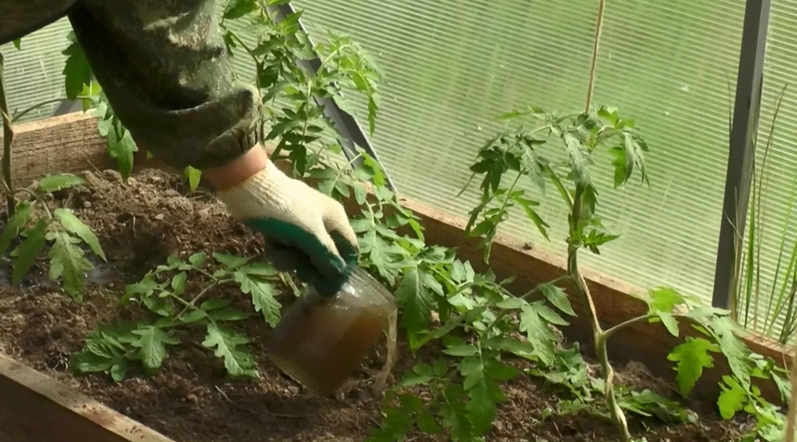
The greenhouse is, in fact, a large greenhouse, where many summer residents grow different agricultural crops. Unlike open soil, the plants diluted here need additional care, since they do not receive a certain concentration of vital elements for them. Tomatoes are no exception - they also need periodic top dressing with nutrient mixtures, mineral or biological fertilizers. Why do you need to feed tomatoes in the greenhouse?
- If you do not provide tomatoes, the immunity of the plants will weaken, they will be subject to attacking malicious insects.
- Many phytopathologies can also develop that can become destructive for tomatoes.
But, on the other hand, it is also not worth getting to feed the tomato too much, since an excess of nutrient and mineral substances has the same destructive effect on the plant as their disadvantage. How often do you need to feed tomatoes in the greenhouse? That's when you need to give a food to plants:
Before planting in the soil:
- Prepare all the holes for picking seedlings in advance.
- Mix the ground with the required amount of organics and mineral fertilizers.
- If you do not, the seedlings in the greenhouse will take root quite poorly, and developing - slowly and sluggish.
14 days after landing:
- By this moment, seedlings are undergoing adaptation.
- In addition, they manage to take root well in the ground, but for normal development they still need vitamin-mineral feeding.
In the phase of active plant growth:
- Before the start of the flowering period, tomatoes begin to actively increase the green mass. To the stems of the tomatoes were thick, they need to be fed.
- At this time, they most need nitrogen and phosphorus from nutrients and mineral components.
- However, follow the observance of the dosing regimen based on these elements.
- Phosphorus will contribute to the development of the root system, and nitrogen - a set of green mass.
During the flowering period:
- At this time, plants are especially in dire need of phosphorus and potassium.
- If these elements are lacking, the flowers will begin to crumble quickly, not having time to pollinate. Therefore, most of the tomato crop will simply be lost.
- However, at this stage of the growth of tomato bushes, it is better to refuse fertilizers containing nitrogen.
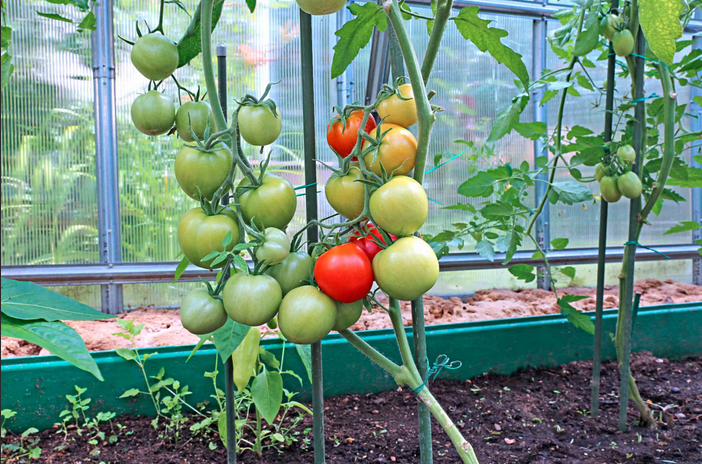
In the phase of fruit formation:
- To form strong ovaries, fruit plants require phosphorus in combination with potassium.
- But it is better to refuse nitrogen, because it affects mainly on the growth of autonomic mass.
- At this stage, you can use both organics and complex mineral fertilizers.
Also read in another article on our website, what to do if the fruits of cucumbers in the greenhouse are poorly poured. You will learn about the reasons and how you can feed.
During the fruiting period:
- Tomato top dressing at this time is necessary so that the fruits are gaining mass faster and ripen.
- Bushes are fertilized with potassium, manganese, boron and iodine.
- It is these elements that make the pulp elastic, fleshy and dense, and also help to increase sugar in it.
Important: The use of any fertilizer and top dressing must be stopped in 2 weeks Before starting the harvest.
Extraordinary use of such funds are allowed only if there are obvious signs of a deficiency of useful substances in tomato bushes.
How to make fertilizers for feeding a tomato in a greenhouse: Rules and recommendations
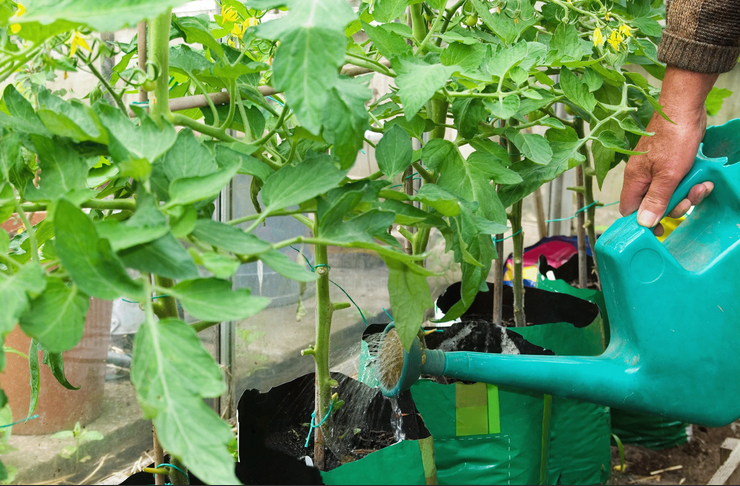
The introduction of top dressing is a simple procedure, however, there are features here. How to make fertilizers for feeding a tomato in a greenhouse? In order not to harm plants, it is necessary to follow such rules and recommendations:
- Perform manipulations to saturate tomatoes with useful substances exclusively in the morning or evening hours. In the afternoon, the sun's rays lead to intensive evaporation of moisture, so greens can simply burn. If the day is cloudy, then you can fertilize tomatoes at any time.
- Before applying fertilizers, pour a bed with seedlings with simple stained water. If this is not done, you can burn the roots of plants with top dressing.
- Follow the dosage. When using a liquid form of fertilizers, add no more 0.5-1 l solution for each bush. But keep in mind that the larger the plant in size, the more fluid it is required for full growth.
- Feed greenhouse tomatoes every 10-14 days. Some summer residents do this more often, which, in principle, is not prohibited. However, in this case, reduce the concentration of nutrients in the drug, or reduce its dose.
On a note: The most strongly tomato seedlings need to be fucked during flowering 4 brushes. At this stage of fertilizer, it is recommended to introduce every 5-7 days.
How can you feed tomatoes in a greenhouse: the use of complex mineral fertilizers
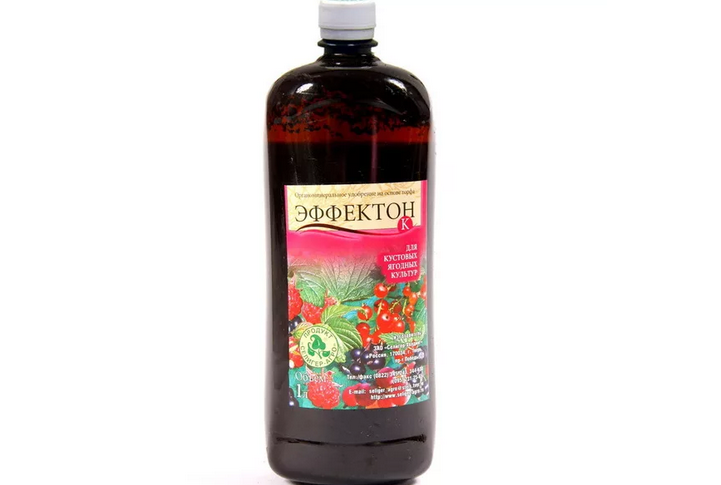
Complex mineral fertilizers is a good option for feeding greenhouse tomatoes. In such means, the necessary components in the correct proportions have already been selected. It remains only to make a choice in favor of one or another top dressing, and the assortment is really very wide. The most popular and often used in gardening are minority:
Effecton:
- Active components of the product are minerals and peat.
- The use of this fertilizer allows you to increase yield at times, as well as change the composition of the soil for the better.
Crystalon:
- Another complex that contains micro- and macro elements necessary for the full development, growth and fruiting of tomatoes.
- The fertilizer is characterized by a prolonged effect, since its components are slowly released and gradually absorbed by roots.
Kemira:
- A comprehensive drug released in granules.
- They are divorced by water immediately before the use of top dressing.
- It is necessary to introduce the resulting solution under the root, avoiding its hit on the green mass.
- Using the drug allows you to saturate the plant with all useful substances for the flowering period.
Ovary:
- This is a whole line of fertilizers intended for processing different garden crops.
- There is a separate drug for tomatoes.
- It contains not only macro and trace elements, but also a complex of healthy acids.
Calcium nitrate:
- In this mineral fertilizer, tomatoes most need during the formation of ovaries.
Important: By making mineral fertilizers, strictly observe the proportions of raw materials and water. And remember that the feeding of top dressing should also be strictly dosed, otherwise you will cause serious harm to the tomatoes.
Organic fertilizers for subcortex of tomatoes in a greenhouse: which is better to make?
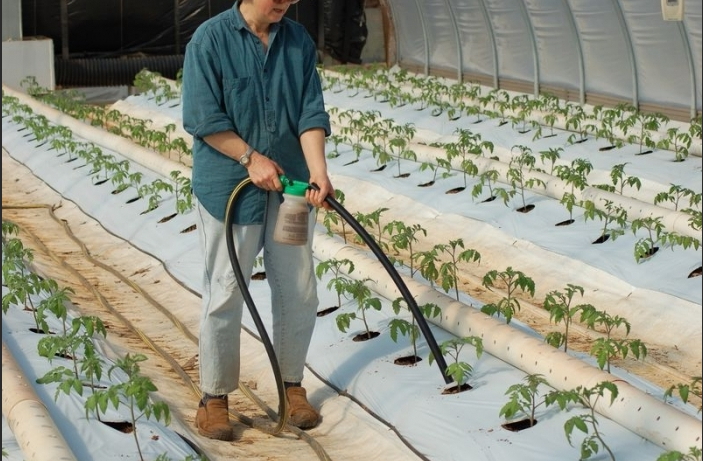
Organic fertilizers are also a good option. Their huge advantage is that they are available, and are very inexpensive. What is better to make organic fertilizers for feeding tomatoes in a greenhouse? Tomatoes in the flowering phase can be fertilized:
- A bird drop
- Horse manure
- Humus
- Mullein
- Peat
- Compost
- Ash
- Siderates
- Sawdust
Organics can be added to the soil in dry form, or as an aqueous solution. Such funds can be used for foliar and root top dressing. If you decide to use a liquid form of top dressing, then first you need to prepare the product correctly:
- To use a mullein, horse manure or peat, take a solid raw material in the calculation 4-5 kg \u200b\u200bper 1 meter square.
- The amount of humus for the same area - 2-3 kg, fresh bird droppings - 400-500 g, dry - half as much.
- Liquid infusions on an organic basis, which can be purchased in a store, before entering the soil, dilute withluded water in the proportion 1:10 respectively.
You can also use folk remedies. Read further.
Folk remedies for feeding tomatoes during flowering in a greenhouse: how to water?

Folk remedies can be a worthy replacement for store fertilizers. They are available, easy to use and safe. But they also need to be used correctly, otherwise there will be no result from their use. How to water? What folk remedies can be used to feed tomatoes during flowering in a greenhouse, and how to prepare a solution? Here's what you can use:
Egg inherent infusion:
- To prepare this tool, take the shell of the 4 eggsGrind in a blender and place in a three -liter jar.
- Pour water to the edges with water, cover with a lid and insist in a darkened cool place for 3 days.
- After that, use the solution for its intended purpose, it is not necessary to filter.
- For each tomato bush, you need approximately 0.5 l prepared top dressing.
It is worth noting that the egg shell is also used to fight the top rot in tomatoes. But there are other equally effective methods.
Nettle infusion:
- It is used to accelerate the flowering process.
- Fay the bucket with fresh plant leaves by two -thirds, then pour them to the top with water and insist in a warm place within 1-1.5 weeks.
- Do not forget to periodically mix the composition, because it is important that it begins to wander.
- After each stirring, cover the tara with infusion with a lid.
- After the allotted time, dilute the resulting drug with clean water in the proportion 1:10.
- Apply fertilizer 1 liter For every tomato bush.
Yeast fertilizer:
- To get it, take 1 bag dry yeast, 3 tbsp. l. sugar and ½ cup warm water.
- Wait for the mixture to wander, and then pour it into 10-liter bucket With water and stir thoroughly.
- Let me brew more 2 hoursthen mix again and add 0.5 liters The resulting solution for each bush of tomatoes.
Ammonia:
- This substance is saturated with nitrogen, therefore it can be used as emergency assistance to accelerate the process of growing up and flowering tomatoes.
- Dilute for processing bushes 2-3 tbsp. l. funds in 10 l water and water each bush with the resulting solution.
- The consumption of the drug is about 1 liter per 1 plant.
- Perform repeated top dressing after 2-3 weeks After the first processing.
Hydrogen peroxide:
- It helps to improve the structure of the soil and its disinfection.
- But for this, peroxide must be used correctly. In a bucket with 10 liters Pour in clean water 10 tablespoons peroxide and stir the solution. Pour it into a spray gun and thoroughly spray the leaves of tomato bushes from all sides.
- Complete the procedure after 14 days.
- You can use this tool and somewhat differently. For soil processing, not green mass, pour in 50 ml of peroxide in 10 l of water. Stir and add no less 1 l liquids for every tomato bush. Perform such processing 1 time per week.
- But keep in mind that the soil should be well spilled at first with clean water, and only then the peroxide solution you prepared.
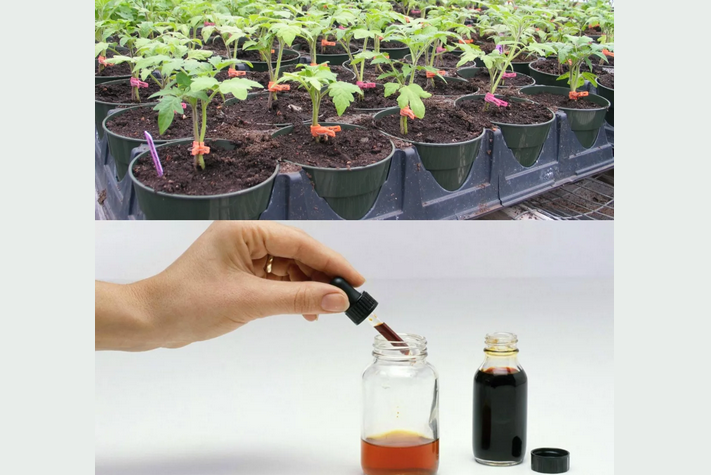
Milk with iodine:
- Also a pretty good option for feeding for tomatoes, which are included in the phase of active flowering.
- Take a liter jar, pour 1 cup milk and bring the volume of fluid before 1 liter clean water.
- Add 4-5 drops of iodineWait for its complete dissolution.
- Stir and season the product into a spray gun.
- Spray the leaves of the bushes from all sides, but do it in cloudy weather so as not to burn the greens.
- Tomato processing with iodine carry out 3-4 times For the entire season, not just during their flowering.
There are still many folk recipes used to feed flowering tomatoes. However, the above preparations of home preparation have established themselves as the most effective and safe products.
Extraordinary top dressing of tomatoes in a greenhouse: what can you fertilize?

In some cases, tomato bushes begin to change their appearance. By this, they signal the lack of certain micro- or macroelements. How can you fertilize? Most often, plants develop a deficiency:
- Nitrogen. It is manifested by a slowdown or termination of the growth of the bush. Urea is used as top dressing.
- Phosphorus. With this deficiency, the lower part of the leaves acquires a bluish color. In this situation, it is advisable to use superphosphate.
- Potassium. In such cases, twisting the upper leaves and the appearance of a brown border on them are noted. To make up for the balance of this element, potassium sulfuric preparations are used.
- Gland. Such a deficiency is discussed with the appearance of obvious signs of chlorosis in tomato bushes. The main fabric of the sheets turns pale, and on its background there are veins of a bright green shade. To eliminate the deficiency of this element, iron is used.
- Calcium. If the tomatoes lack this particular substance, they will grow thin and excessively elongated. To saturate plants with this element, it is recommended to use calcium nitrate.
If there are no signs of a lack of micro- or macroelements, it is not necessary to perform extraordinary top dressing of tomatoes in the greenhouse. After all, an overabundance of a particular substance is as harmful as its deficiency.
Growing tomatoes in a greenhouse is practically no different from how this happens in open ground. However, as mentioned earlier, such plants need more fed up more due to the fact that they are in a limited, closed space. There are a lot of top dressing options, you do not have to rack your head about this. Choose the most optimal option for yourself, read the instructions carefully and follow it exactly. This is all that you need to do to get the most rich in tomato crop. Good luck!

